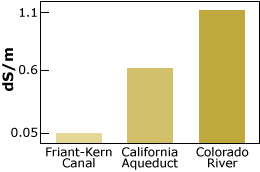Salinity Management Guide
Fundamentals
Measures of salinity
For water at Earth's surface — rainwater, snow, lakes, streams, and shallow groundwater — the solute load typically consists mostly of inorganic ions and compounds. If a sample of such water is filtered to remove suspended solids, then stored in a low-humidity environment long enough to evaporate completely, a residue of solid material will remain in the sample container. Dividing the mass of that residue by the volume of solution originally present yields a parameter known as total dissolved solids (TDS). TDS is expressed in milligrams per liter (mg/L).
Rainwater typically has a TDS of 20 mg/L or less. Fresh water from lakes, rivers, and groundwater is more variable, with TDS ranging from 20 mg/L to approximately 1,000 mg/L. Brackish water is, by definition, water with TDS exceeding 1,000 mg/L and ranging as high as that of seawater, at approximately 35,000 mg/L.

California irrigation waters are relatively low in salt.
Groundwater deep within gypsum beds or other geological formations that consist of highly soluble salt can have TDS even higher than that of seawater. Such fluids are termed saline water (which has a TDS of 35,000 to 100,000 mg/L) or brine (TDS over 100,000 mg/L).
Most water that's acceptable for irrigation of landscapes contains 200 to 800 mg/L of dissolved salts. Total soluble salt levels up to 2,000 mg/L may be tolerated by certain plant species, but only on soils with exceptional permeability and subsoil drainage. (Good permeability and drainage allow a landscape manager to leach excessive salts from the root zone by periodically applying heavy irrigations. Leaching is described in more detail in a separate section of this tutorial.)
Electrical conductivity, EC
The electrical conductivity of water, or ECw, is the principal parameter used nowadays to measure a solution's salt content. EC can be measured quickly and easily, either in the laboratory or in the field. The readings are temperature dependent; therefore, measurements typically are corrected to an equivalent value at 25 degrees Celsius.
The internationally accepted standard unit for reporting ECw is deciSiemens per meter (dS/m). Note that this standard unit was adopted relatively recently. An older, equivalent unit often appears in water quality reports from the 1980s or earlier: millimhos per centimeter. (Although the term "mhos" may at first appear strange, it was chosen by early researchers for reasons that involve physics. EC, as its name implies, is a type of conductivity — the opposite of resistivity, measured in ohms. Hence, for EC, researchers adopted the term "mho" — "ohm" written backwards.)
Here is a quick summary of the various EC units you may encounter when reading papers from the literature:
1 dS/m = 1 mmho/cm = 1000 μmho/cm
EC works well as a proxy for total dissolved solids because a water's ability to conduct an electrical current is directly related to the concentration of salts in solution. In other words, salty water is a good conductor of electrical current, whereas pure water is a poor conductor.
Most water used for irrigation in California has an ECw in the range 0.1 to one deciSiemen per meter. Waters that have ECw in excess of 0.7 dS/m (corresponding to a TDS of about 450 mg/L) must be managed a bit more carefully if salinity problems are to be held in check.
An ECw of 3 dS/m (equivalent to a TDS of about 2000 mg/L) is the upper limit for nearly all landscape plants. (Most plants cannot tolerate salinity higher than that.) Therefore, avoid using for irrigation any water that approaches or exceeds that level of salinity.

An ECw of 3 dS/m is the upper limit for irrigation.
Estimating TDS from EC
A mathematical relationship between ECw and TDS has been devised, making it easy to correlate one type of measurement with the other. For most water, TDS, in milligrams per liter, is equivalent to approximately 640 times EC, in deciSiemens per centimeter.
TDS (in mg/L) = ECw (in dS/m) × 640
The coefficient of 640 in the equation above is appropriate for a fairly wide range of conditions. For waters of mixed composition, consider using a factor of 735 instead, and for concentrated solutions with EC exceeding 5 dS/m, consider using a factor of 800.
| « Previous page | Next page » |